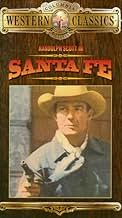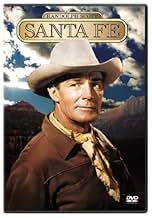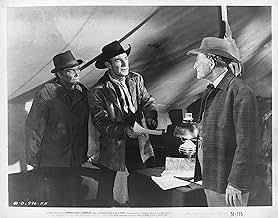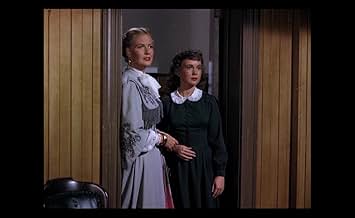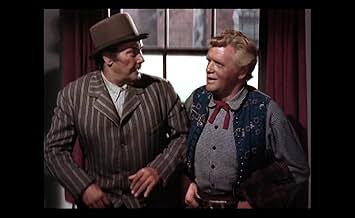IMDb-BEWERTUNG
6,1/10
1224
IHRE BEWERTUNG
Füge eine Handlung in deiner Sprache hinzuAfter their service in the Civil War, four brothers go their separate ways, but later find themselves on opposite sides of a final showdown.After their service in the Civil War, four brothers go their separate ways, but later find themselves on opposite sides of a final showdown.After their service in the Civil War, four brothers go their separate ways, but later find themselves on opposite sides of a final showdown.
- Regie
- Drehbuch
- Hauptbesetzung
Peter M. Thompson
- Tom Canfield
- (as Peter Thompson)
Olin Howland
- Dan Dugan
- (as Olin Howlin)
Jock Mahoney
- Crake
- (as Jock O'Mahoney)
Empfohlene Bewertungen
Train Buffs will Enjoy this Stiff Account of the "Iron Horse" and its Celebration as the Catalyst for "Manifest Destiny" that would Not be Denied.
It's Not Cinemascope, but a Technicolor Film.
The Post Civil-War Story and the Bitterness is Threaded Throughout the Plot but goes Virtually Nowhere.
The Acting is Stoic.
The Comedy Relief is Labored.
The Action is Average Stuff when it Occurs, and it's Not Often.
This is a Good Example of the Studio System Entering the Second Half of the 20th Century Riding the Rails of Past Glories.
Laziness Resulted in Bloated Productions that Became more Product than Art.
The Fat-Cats in Hollywood would Drain the System for another 20 Years before it Finally Gave Up the Ghost.
1950 was about the Beginning of the Decline.
There was a Sense of Atrophy as the Movie Machine made its way after a Two Decade Ride of Full Control.
Thankfully Randolph Scott would Ride the 1950's Proud as He Hooked Up with Budd Boetticher.
Excellent Movie Entertainment that were Self-Produced.
It's Not Cinemascope, but a Technicolor Film.
The Post Civil-War Story and the Bitterness is Threaded Throughout the Plot but goes Virtually Nowhere.
The Acting is Stoic.
The Comedy Relief is Labored.
The Action is Average Stuff when it Occurs, and it's Not Often.
This is a Good Example of the Studio System Entering the Second Half of the 20th Century Riding the Rails of Past Glories.
Laziness Resulted in Bloated Productions that Became more Product than Art.
The Fat-Cats in Hollywood would Drain the System for another 20 Years before it Finally Gave Up the Ghost.
1950 was about the Beginning of the Decline.
There was a Sense of Atrophy as the Movie Machine made its way after a Two Decade Ride of Full Control.
Thankfully Randolph Scott would Ride the 1950's Proud as He Hooked Up with Budd Boetticher.
Excellent Movie Entertainment that were Self-Produced.
I remember that rather hilarious line from "Blazing Saddles", but I think this is the first film with Mr. Scott I've ever seen.
He was kind of the poor man's John Wayne.
The plot here is that the Civil War is over, and while his brothers carry around a lot of anger about what happened during the war, Randolf plays a guy who goes to work helping to organize and build railroads connecting the west with the rest of the country.
Some parts of the film, like the scene with the native Americans, and they remark "Some day we'll name a train after you, Chief." (Ha, ha, "Super-chief" How funny. Almost takes the sting off the genocide!) The brothers take to train robbing after gambling doesn't work out for them, and there's a bit of pathos between the good guys and bad guys and the historical Bat Matherson being dropped into the mix.
He was kind of the poor man's John Wayne.
The plot here is that the Civil War is over, and while his brothers carry around a lot of anger about what happened during the war, Randolf plays a guy who goes to work helping to organize and build railroads connecting the west with the rest of the country.
Some parts of the film, like the scene with the native Americans, and they remark "Some day we'll name a train after you, Chief." (Ha, ha, "Super-chief" How funny. Almost takes the sting off the genocide!) The brothers take to train robbing after gambling doesn't work out for them, and there's a bit of pathos between the good guys and bad guys and the historical Bat Matherson being dropped into the mix.
Santa Fe is directed by Irving Pichel and adapted to screenplay by Kenneth Gamet from the James Marshall novel and a story by Louis Stevens. It stars Randolph Scott, Janis Carter, Peter M. Thompson, Jerome Courtland and John Archer. A Technicolor production, it's photographed by Charles Lawton Jr. Story is set following the American Civil war and finds Scott as Britt Canfield, one of four ex-Confederate brothers heading West for a new life. While Britt finds honest employment on the Santa Fe railroad, his brothers veer towards the other side of the law.
A routine Western boosted by some quality set pieces and a well crafted script. Watchable from the off, film follows a true course whilst launching off narratively from the bitterness still felt by those who were on opposite sides of the war. It pitches Scott front and centre as the stoic character fending off all sorts of challenges, challenges that come courtesy of Indians, rival companies and his own kin! The acting around Scott is pretty average, tho the comic relief from Billy House & Olin Howland is most appealing, while it would have been nice to have some more imposing scenery filling out the screen. All told it's a safe recommendation to Western fans, even if ultimately it's not a genre film to revisit often. 6/10
A routine Western boosted by some quality set pieces and a well crafted script. Watchable from the off, film follows a true course whilst launching off narratively from the bitterness still felt by those who were on opposite sides of the war. It pitches Scott front and centre as the stoic character fending off all sorts of challenges, challenges that come courtesy of Indians, rival companies and his own kin! The acting around Scott is pretty average, tho the comic relief from Billy House & Olin Howland is most appealing, while it would have been nice to have some more imposing scenery filling out the screen. All told it's a safe recommendation to Western fans, even if ultimately it's not a genre film to revisit often. 6/10
Randolph Scott was well into his fifties by the time of this movie, and still doing a lot of his own action scenes and stunts.
Many movie stars of those days stayed fit by lifting weights and swimming - guys like Cary Grant and Fred Astaire - both lifelong friends of Randolph Scott - had weight rooms in their homes and also at their home studio (Astaire who was a flyweight of around 145 lbs., worked out with 5lb bells and would do hundreds of reps while rehearsing dance steps!). John Wayne was a serious weight lifter who would rack up some amazing reps with the curling bars, and Charles Bronson had some ingenious gadgets for isometric exercises. Robert Taylor was a track star in college, and would run for miles at a stretch on his ranch.
Other actors, though, like Joel McCrea, Gary Cooper, Clark Gable, and our "Santa Fe" star, Randolph Scott, stayed fit simply by working their ranches.
In this movie, Scott looks like a rawhide whip, his movements lithe and graceful and the moving camera shots (taken from a pickup) of him galloping on horseback show a stunning physique. An old friend of this reviewer's family used to tell a story of Randolph Scott pulling an old 1940s Ford pickup around with a rope. For those of us who have worked around vehicles from that era, that really is an amazing feat of strength.
Scott is surrounded by... maybe less than stellar performers for "Santa Fe," and this doesn't feel like one of his greatest performances. But it's got plenty of action and drama for a Saturday afternoon movie.
Many movie stars of those days stayed fit by lifting weights and swimming - guys like Cary Grant and Fred Astaire - both lifelong friends of Randolph Scott - had weight rooms in their homes and also at their home studio (Astaire who was a flyweight of around 145 lbs., worked out with 5lb bells and would do hundreds of reps while rehearsing dance steps!). John Wayne was a serious weight lifter who would rack up some amazing reps with the curling bars, and Charles Bronson had some ingenious gadgets for isometric exercises. Robert Taylor was a track star in college, and would run for miles at a stretch on his ranch.
Other actors, though, like Joel McCrea, Gary Cooper, Clark Gable, and our "Santa Fe" star, Randolph Scott, stayed fit simply by working their ranches.
In this movie, Scott looks like a rawhide whip, his movements lithe and graceful and the moving camera shots (taken from a pickup) of him galloping on horseback show a stunning physique. An old friend of this reviewer's family used to tell a story of Randolph Scott pulling an old 1940s Ford pickup around with a rope. For those of us who have worked around vehicles from that era, that really is an amazing feat of strength.
Scott is surrounded by... maybe less than stellar performers for "Santa Fe," and this doesn't feel like one of his greatest performances. But it's got plenty of action and drama for a Saturday afternoon movie.
Good but not great old time shoot-em-up western. Typical Randolph Scott pic. Brother agains brother tale. Old North/South post-war conflict. Certainly worth the 90 minutes. Good for a rainy day or lazy afternoon watch. Lots of cliches, but all good cliches. Nice cinematography. Trains. Nice sets and costumes. Black hats vs White hats. Decent acting by a lot of faces you recognize but do not know the names. Very good flat car fight on the train at the end. Of course Randolph (white hat) prevails. Last line is a classic. "As the railroad grows, so will America. You darn tootin. Please enjoy if you get the chance.
Wusstest du schon
- WissenswertesAfter the Indian chief ran the train, Scott told the chief someday they will name a train after him. They did: the Santa Fe Super Chief.
- PatzerThe narration says Lincoln said "with malice toward none, with charity towards all" at Gettysburg. The quote is from his second inaugural address delivered at the capitol.
Top-Auswahl
Melde dich zum Bewerten an und greife auf die Watchlist für personalisierte Empfehlungen zu.
- How long is Santa Fe?Powered by Alexa
Details
- Laufzeit1 Stunde 27 Minuten
- Seitenverhältnis
- 1.33 : 1
Zu dieser Seite beitragen
Bearbeitung vorschlagen oder fehlenden Inhalt hinzufügen

Oberste Lücke
By what name was Unsichtbare Gegner (1951) officially released in India in English?
Antwort
